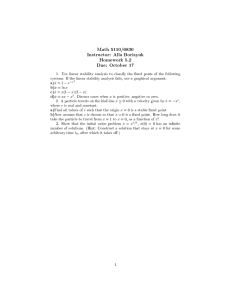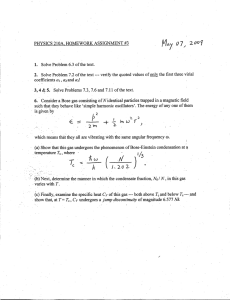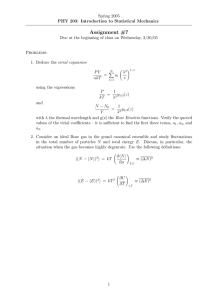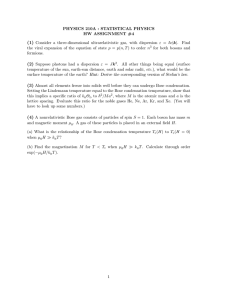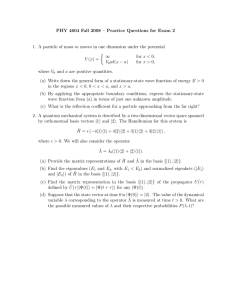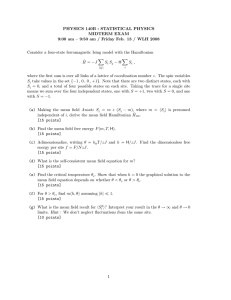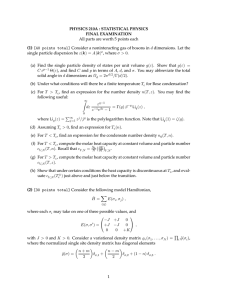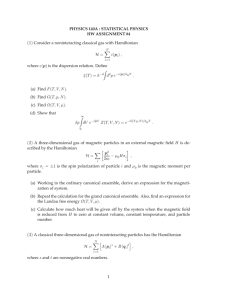1 Lectures 4, 5.
advertisement
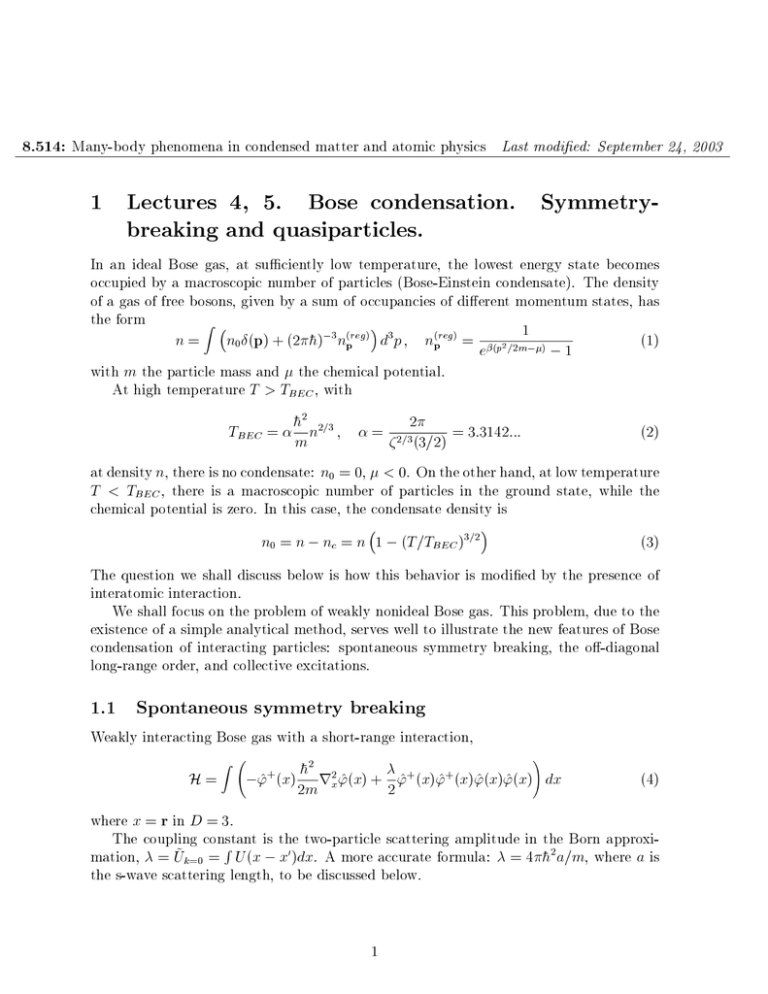
8.514:
Many-body phenomena in condensed matter and atomic physics Last modi ed: September 24, 2003
1 Lectures 4, 5. Bose condensation. Symmetrybreaking and quasiparticles.
In an ideal Bose gas, at suciently low temperature, the lowest energy state becomes
occupied by a macroscopic number of particles (Bose-Einstein condensate). The density
of a gas of free bosons, given by a sum of occupancies of dierent momentum states, has
the form
Z
n = n0 (p) + (2h
);3np(reg) d3p np(reg) = e (p2 =2m1;) ; 1
(1)
with m the particle mass and the chemical potential.
At high temperature T > TBEC , with
2
h
TBEC = m n2=3 = 2=32(3 =2) = 3:3142:::
(2)
at density n, there is no condensate: n0 = 0, < 0. On the other hand, at low temperature
T < TBEC , there is a macroscopic number of particles in the ground state, while the
chemical potential is zero. In this case, the condensate density is
(3)
n0 = n ; nc = n 1 ; (T =TBEC )3=2
The question we shall discuss below is how this behavior is modied by the presence of
interatomic interaction.
We shall focus on the problem of weakly nonideal Bose gas. This problem, due to the
existence of a simple analytical method, serves well to illustrate the new features of Bose
condensation of interacting particles: spontaneous symmetry breaking, the o-diagonal
long-range order, and collective excitations.
1.1 Spontaneous symmetry breaking
Weakly interacting Bose gas with a short-range interaction,
H=
Z
!
2
h
;'^+ (x) 2m r2x'^(x) + 2 '^+(x)'^+ (x)'^(x)'^(x) dx
(4)
where x = r in D = 3.
The coupling constant
R is the two-particle scattering amplitude in the Born approximation, = U~k�0 = U (x ; x0 )dx. A more accurate formula: = 4h
2a=m, where a is
the s-wave scattering length, to be discussed below.
1
The ground state at T = 0 is characterized by large occupation number of the k = 0
state. In number representation, the BEC state of N particles is jBEC i = jNk�0 0 0 :::i,
i.e.
(p
ak�0jB ECN i = N jBECN ;1i k = 0
(5)
0
k 6= 0
This formula,p at large N , suggests to replace the number state by a coherent state,
a0 jBEC i = N jBEC i, which is equivalent to replacing the operator a^0 by a c-number
p
N.
This can be achieved if the BEC state is understood as a coherent state, which requires
considering the problem (4) in the 'big' space with all particle numbers allowed. Such
an approach gives results equivalent to that of the problem with xed particle number
N in the limit N ! 1, since for a coherent state h N 2 i1=2 = N 1=2 N . Uponqsuch a
replacement, the eld operator '^ = V ;1=2 Pk ak eikr turns into a classical eld ' = N=V ,
where V is system volume.
To that end, we are led to consider the coherent states
p
j'i = exp V 'a^+0 ; '
a^0 j0i = e;
V j'j
1
X
p m
V'
p jmi
(6)
m!
which have the desired property '^j'i = 'j'i. These states do not correspond to any
specic number of particles, in fact they are characterized by a distribution of particle
numb
Accordingly, the states j'i are not invariant under the number operator N^ =
P a+ears,. while
the hamiltonian (4) commutes with N^ . One has to understand why the
k k k
BEC state apparently does not respect the particle number conservation.
We start by noting that
1
2
2
m�0
eiN^ j'i = jei'i eiN^ He;iN^ = H
(7)
i.e. the operator eiN^ , applied to j'i, produces a state of the same energy, with a phase2
of ' shifted by . Since the overlap of coherent states obeys jh'0j'ij2 = e;V j' ;'j ,
any two dierent states j'i, j'0i are orthogonal in the limit V ! 1. Thus the states
with dierent phase factors, j'i, jei'i, are macroscopically distinct. This observation
demonstrates that the BEC states form a degenerate manifold parameterized by a phase
variable 0 < < 2.
To clarify the origin of this degeneracy, let us nd the states j'i that provide minimum
to the energy (4). Taking minimum at xed particle density can be achieved by adding
to H a term proportional to N^ , H ! H ; N^ . Taking the expectation value, obtain
U (') = h'jH ; N^ j'i = 2 j'j4 ; j'j2
(8)
| the so-called Mexican hat potential. The energy minima are found on the circle j'j2 =
=, i.e. the phase of ' is arbitrary, while the modulus j'j is xed, thereby giving a
0
2
relation between the density and chemical potential, = n.1
From the symmetry point of view, the systuation is quite interesting. The microscopic
hamiltonian (4) has global U (1) symmetry, since it is invariant under adding a constant
phase factor to the wavefunction of the system, '^ ! ei'^. The ground states, however,
do not possess this symmetry: adding a phase factor to the state j'i produces a dierent
ground state. This phenomenon, called spontaneous symmetry breaking, is absent in the
noninteracting Bose gas. In the interacting system, the U (1) symmetry breaking has a
very fundamental consequence: it leads to superuidity.
There is yet another way to understand the phenomenon of U (1) symmetry breaking,
due to Penrose and Onsager, that does not require to consider the states with uctuating
particle number. One can instead start with the density matrix of the Bose gas (4) ground
state ji in the coordinate representation,
R(x x0 ) = h j'^+(x0 )'^(x)j i
(9)
Using the translational invariance, one expects that the quantity (9) will depend only on
the distance x ; x0 between the two points. By going to Fourier representation, one can
transform (9) to the form
Z
3
d
0
;
i
k
(x;x )
R(x x ) = e
nk (2k)3 nk = h ja^+k a^kji
(10)
In a Bose condensate, the particle distribution nk has singularity at k = 0,
nk = n0(2)3 (k) + f (k)
(11)
where f (k) is a smooth function. Accordingly, the density matrix (10) has two terms,
Z
3
0
0
0
~
~
R(x x ) = n0 + f (x ; x ) f (x ; x ) e;ik(x;x ) fk (2dk)3
(12)
the constant n0, independent of point separtion, and the second part, f~(x ; x0 ), that
vanishes at large jx ; x0j.
A density matrix that does not vanish at large point separtion represents an anomaly
(recall that in any ordinary liquid all correlations vanish at several interatomic distances).
The nite limit n0 = limjx;x j!1h j'^+(x0 )'^(x)ji suggests p
that the quantities 'p
^(x),
+ 0
i
+
;
i
'^ (x ) in some sense have nite expectation values: h'^(x)i = e n0 , h'^ (x)i = e n0,
with xed modulus, but an undetermined phase. The name O-diagonal Long-range
Order, or ODLRO, associated with this phenomenon, expresses the fact that in the
density matrix the ordering is revealed by the behavio of the o-diagonal component
R(x x0 )jx;x j!1.
0
0
0
0
In a nite, but large system, with xed particle number, the true ground state (TGS) of a quantummechanical hamiltonian is nondegenerate. This TGS is isotropic in ', due to boundary eects that split
the circular manifold. The statement about the absence of degeneracy of TGS in a nite system is
formally coirrect, but misleading, since this TGS is not 'pure'. Typically, at any moment of time the
state is characterized by a global phase, changing slowly as a function of time. (In D = 3 the mixing of
''s with dierent phases results from vortices passing across the system, from one boundary to another.)
1
3
1.2 Quasiparticles
p
To study the excitations above the ground state, we substitute a^0 = N , a c-number, in
the hamiltonian (4), and keep quadratic terms,
+
X
1 X a+a+ + a a (13)
H ; N^ = 21 n2 V + (0)
k ;k
k ; + 2n ak ak + 2 n
k ;k
k�0
6
k6�0
X (0) +
+
+ +
+
= 1 n2V +
(
a
a
+
a
a
)
+
n
(
a
+
a
)
(
a
+
a
)
(14)
k
k
k
k k
;k ;k
;k
;k
2
(k;k)
where the sum is taken over pairs (k ;k) Here we used the value = n obtained above.
At this stage, it is convenient to introduce the quantities q^k = p12 (ak + a;+k), p^k =
pi (a+;k ; ak ). These operators are non-hermitian, q^k+ = q^;k , p^+k = p^;k , but obey the
2
standard p q algebra, q^k p^k ] = kk , which allows to treat them as coordinate and
momentum. In terms of the operators p^k, q^k the hamiltonian is represented as a sum of
independent harmonic oscillators. Indeed, since a+k ak + a+;ka;k = p^+k p^k + q^k+q^k , we can
rewrite the hamiltonian as follows:
+ X (0) +
H = 21 n2 V +
k p^k p^k + (0)
+
2
n
qk q^k
(15)
k
0
0
(k;k)
This hamiltonian, quadratic in q^k , p^k, can be brought to the normal form by a rescaling
(squeezing) transformation
(0)
q^k = ek q^k0 p^k = e;k p^0k e4k = (0) k
(16)
k + 2n
which acts on the operators ak, a+k as
ak = cosh kbk ; sinh k b+;k a+;k = cosh k b+;k ; sinh k bk
(17)
(see Lecture 2). The transformation (17), called Bogoliubov transformation, can be shown
to preserve the canonical commutation relations, bk b+k ] = 1.
The hamiltonian is now reduced to
X
X
H = 21 n2 V +
Ek b+k bk + b+;k b;k = 12 n2V + Ekb+k bk
(18)
k�0
6
(k;k)
describing a gas of Bogoliubov quasiparticles, the noninteracting bosons created and annihilated by the operators b+k , bk , having energy
r
2
2
Ek = (0)
(19)
k + n ; (n)
The new ground state is annihilated by all the bk . Since for the ground state of the ideal
Bose gas akj0 i = 0, and the transformation (17) can be represented as bk = Uak U ;1 ,
b+k = Ua+k U ;1 , with
0
1
X
U = exp @ k a+k a;+k ; aka;k =2A
(20)
k�
6 0
4
(see Lecture 2), one can write the new ground state as j i = U j0 i.
The dispersion relation (19), for small k, is linear,
q
Ek = hc
jkj c = n=m
(21)
which is characteristic for sound waves in a uid. For higher values of k, the dispersion
takes the form of a usual free-particle expression Ek = h
2k2 =2m + n.
Remarkably, both the collective modes, sound waves, and the single-particle excitations appear on the same dispersion curve, gradually blending into one another at the
energy ca. Ek ' n. One can gain some insight into the dierence of the modes at large
and small k by considering the eld equations
2
ih@
t '^ = '
^ (H ; N^ )] = ; 2h
m r2'^ + '^+'^2 ; '^
(22)
2
;ih@
t '^+ = (H ; N^ ) '^+] = ; 2h
m r2 '^+ + ('^+)2 '^ ; '^+
(23)
It is instructive to treat these equations as a q
classical dynamics problem, linearizing near
stationary solution, ' = '0 + , where '0 = =. The linearized equation has solution
of the form
(r t) = aeikr;i!t + be;ikr+i!t
(24)
r
2
2
with h!
= (0)
k + n ; (n) the same as Eq.(19). In other words, one can consider condensate with uctuating amplitude and phase, and show that these uctuations
propagate in just the same way as the collective modes (19).
In such an approach, the dierence between small and large k follows from the relation
between the amplitudes a and b obtained from the dynamical equation. At small k, the
sum a + b is much smaller than the dierence a ; b. This means that the oscillations
are predominantly in the phase of the eld ', not in the modulus, just as one expects
from Goldstone theorem (and the above Mexican hat picture). At large k, however, the
normal modes have a + b or a ; b nearly equal in magnitude, which means that the
oscillation follows a small circle in the complex ' plane, i.e. the phase and the modulus
of ' participate in the collective oscillations roughly equally.
We can use the above results to estimate the eect of condensate depletion due to
interactions. The total density of all particles in the system can be written as
X
X
n = h ja+0 a0 + ak+ak ji = n0 + sinh2 kh jbkb+k ji
(25)
6
k6�0
1
0 k�0
(0)
XB
CCA
r k +n
= n0 + 12 B
;
1
@
2
2
k�0
6
(0)
k + n ; (n)
(26)
Estimating the sum as O(3=2), we nd that the condensate depletion is a small eect. In
contrast, in superfuid 4He only few percent of the helium atoms are in the single-particle
ground state.
5
